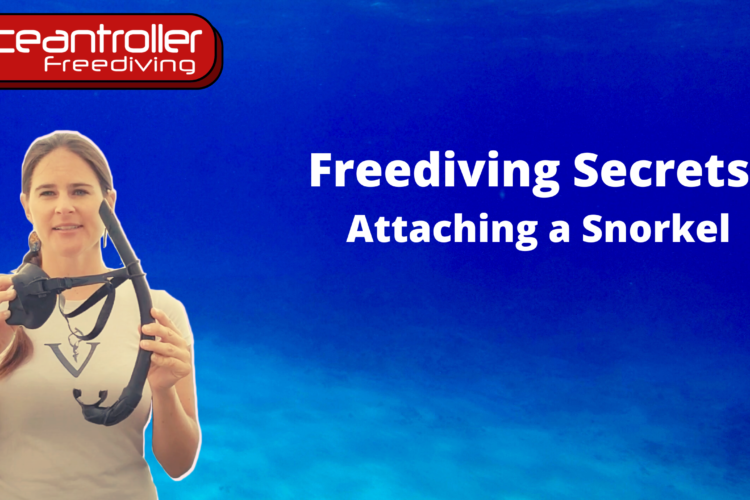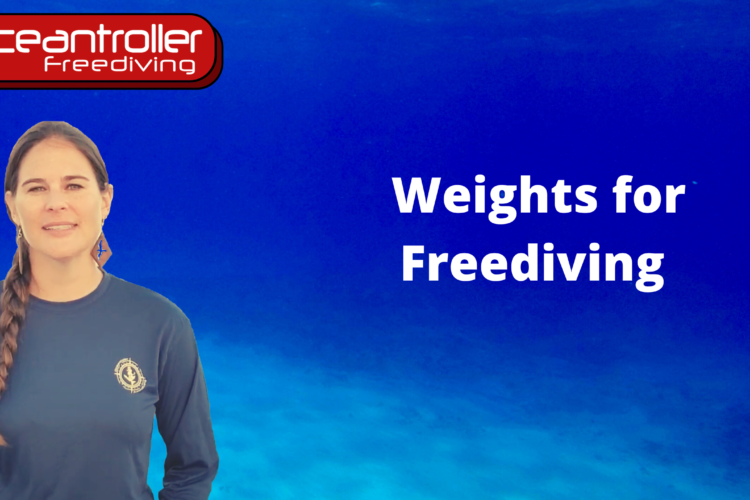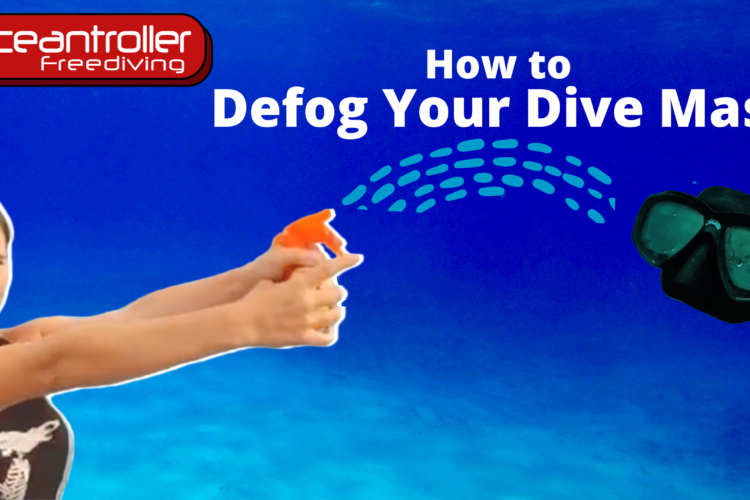Welcome to Water Tip Wednesday. I’m Jackie Troller with Oceantroller snorkeling and free diving sharing with you a free divers’ secret to attaching a snorkel.
You may be wondering should I attach my snorkel to the left or the right side of my mask? Well the answer is neither free divers attach their snorkels to the backside of their mask straps. Think about attaching your snorkel to the side of the strap when your head goes in, the snorkel tube tends to follow, becoming parallel to the surface of the water and allowing water to come in. Attaching your snorkel to the backside of your mask strap keeps your snorkel tube in more of a perpendicular position to the water surface as you look at the fish. Just use a simple hair tie. Place it over the snorkel tube, feed it through the back side of the mask strap, give it a twist and put the loop back over the tube, pull it down a little bit to get it repositioned. You’ll see that the snorkel on this particular mask strap has a tendency to go to one side or the other scuba divers. They prefer having their snorkel tube on the left side because the regulator set up is on the right for free diving I guess it doesn’t really matter. It’s just up to you. Another advantage of positioning the snorkel on the back of your mask. Is free divers spit out their snorkel before they dive. So having your snorkel at the backside of your mask allows it to be pulled away towards the back of your head instead of hitting you on the side of the face for the duration of your dive.
Well, that’s your water tip for today. See you guys next time. Never dive alone.
Oceantroller out.
Welcome to Water Tip Wednesday. I’m Jackie Troy with Oceantroller snorkeling and freediving, helping you find the right freediving weight belt.
Weight belts come in different materials nylon webbing and rubber. Nylon webbing is very slippery. Not only do the weights slide back and forth from side to side, but you’ll find these weight belts will slide up and down your torso, making your dive very uncomfortable. Freedivers prefer rubber belts because they tend to stick to your wetsuit better and the weights don’t slide around. waist belts also have different types of buckles. This particular buckle cinches down, but there are freediving rubber weight belts that are similar to a regular belt you would wear with a tongue pin and notches, I prefer the one that cinches down so I can make micro adjustments as my wetsuit compresses or as needed. Whereas with the notches, you’re stuck with a certain size and you can’t make those micro adjustments. The standard way to put on a weight belt is so that it is right hand release, which means you hold the belt buckle in your left hand, bring it around your waist, feed it through, and this is the part that makes it right hand release. Remember when we talked about diaphragmatic breathing, placing your weight belt on your lower hips is very important so that you do not hinder your belly breathing, or your ability to maximize your inhale. If you find that your rubber weight belt still tends to ride up onto your ribs as you’re diving, especially for women to purchase a cross strap and just slide it over your belt. The best types of weights to use are the square lead weights as the cylinder ones tend to dig into your body. Well that’s your water tip for today. Next week we’ll cover how to weight yourself properly. Until then dive safe. Never dive alone. Oceantroller out.
Welcome to Water Tip Wednesday. I’m Jackie Troller with Oceantroller snorkeling and freediving, helping you find the right mask.
Numerous mask options are available, but if you want to dive on your own supply, get depth with your own breath, you need a low volume mask that fits your face comfortably. Why low volume? Low volume masks allow you to be selfish with your air. It’s a smaller space that you’re giving away air to. Large volume masks take a lot more effort to equalize, cause discomfort and can increase your risk of getting a mask squeeze. So unless you want to look like you’re straight out of a horror film for a couple weeks stick to low volume. How do you find a mask that’s the right fit for you? I’ve seen way too many snorkelers and freedivers use their mask strap, as a ratchet strap. Residual lines on your face after a dive are not sexy nor comfortable. When trying out a mask, do not put on the mask strap. Hold the mask to your face. Clear any hair so it cannot get in the way of a seal. Inhale through your nose and you should be able to gently pull away and the mask will remain suction to your face this is how you know you have a good fit. I recommend trying on many makes and models to ensure that your nose has a comfortable nose pocket and that no hard parts of the mask are hitting your skin. Lastly, if you’re tempted to get a neoprene mask strap cover…DON’T DO IT! Your mask strap will slide off your head if you’re snorkeling or freediving. Ladies, be careful about putting conditioner in your hair; it may also cause your mask strap to slip off your head. Gentleman with mustaches… use silicone compatible gels not products like Vaseline as the petroleum-based products do not go well with the silicone mask skirts. Well, that’s your water tip for today. See you guys next week. Never dive alone.
Oceantroller out.
Welcome to Water Tip Wednesday I’m Jackie Troller, with Oceantoller snorkeling and free diving sharing with you how to find the right amount of weight for free diving.
Untrained snorkelers and free divers tend to overweight themselves, which I guess is good for a ride down. But what about having the kick all of that weight back up to the surface in the most crucial part of your dive 90% of blackouts happen at the surface even after a divers taken a breath or two. So over weighting yourself could cost you your life, finding the right amount of weights depends on your body size, weight, body composition, wetsuit thickness, and whether you’re diving in freshwater versus saltwater. A general rule for Saltwater is that if you’re wearing a three millimeter wet suit, you’ll be about two to four pounds, five mil six to eight pounds, seven mil 10 to 12 pounds, it’s helpful to use smaller weight increments because on average, my students are only off by one to two pounds. To further customize your weight, you’ll want to get in the water with your wetsuit and wet belt. Perform a peak inhale, which means you’re inhaling with your diaphragm, chest shoulders. And upon holding your breath without kicking or sculling, the waterline should be about collarbone. The goal is to be neutrally buoyant at 10 meters or 33 feet again, this is because 90% of blackouts happen at the surface and 9% of blackouts happen between 15 feet and the surface. Well, that’s your water tip for today. See you guys next time! Never dive alone.
Oceantroller out.
Welcome to Water Tip Wednesday. I’m Jackie Troller with Oceantroller Snorkeling and Freediving, sharing with you how to keep your mask from fogging. Imagine, you splash in the water ready to check out some fish, but you can’t see anything.
Foggy masks are beyond frustrating. Trust me.. I know from experience. So why does this happen to you? Or to me? When masks are produced, a thin silicone layer is left over from the manufacturing process. This thin layer is the culprit. This is the reason why no amount of spit or defog will help keep your mask clear. The solution? Use an abrasive gritty toothpaste, not the clear gel kind. Rub it around your mask for several minutes. Some people even leave the toothpaste in their mask overnight. Keep in mind this method is for glass lenses only, not for plastic lenses. If you use abrasive toothpaste on plastic lenses it’s just going to scratch them up. Another method to take out the silicone layer from glass lenses, is to burn it using a lighter or a match in a swift motion around the lens. It should turn black. This is good. This is the silicone layer burning off. However, manufacturers will take back their warranty if you use this method and you want to be careful not to burn the silicone skirt of your mask. In some cases, masks have cracked on divers from too much heat for too long. So if you use the burning method…. it’s on you. Lastly, before every dive, I recommend either using spit or filling a spray bottle full of no tears baby shampoo diluted with water and spraying it in your mask before every dive.
That’s your water tip for today, see you guys next Wednesday. Oceantroller out.








